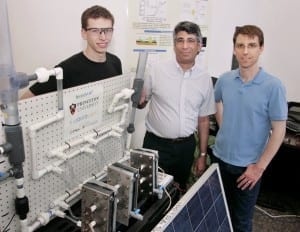Using waste carbon dioxide and easily obtained machined parts, this approach offers a promising route to a renewable fuel
Research to curb global warming caused by rising levels of atmospheric greenhouse gases, such as carbon dioxide, usually involves three areas: Developing alternative energy sources, capturing and storing greenhouse gases, and repurposing excess greenhouse gases. Drawing on two of these approaches, researchers in the laboratory of Andrew Bocarsly, a Princeton professor of chemistry, collaborated with researchers at start-up company Liquid Light Inc. of Monmouth Junction, New Jersey, to devise an efficient method for harnessing sunlight to convert carbon dioxide into a potential alternative fuel known as formic acid. The study was published June 13 in the Journal of CO2 Utilization.
The transformation from carbon dioxide and water to formic acid was powered by a commercial solar panel provided by the energy company PSE&G that can be found atop electric poles across New Jersey. The process takes place inside an electrochemical cell, which consists of metal plates the size of rectangular lunch-boxes that enclose liquid-carrying channels.
To maximize the efficiency of the system, the amount of power produced by the solar panel must match the amount of power the electrochemical cell can handle, said Bocarsly. This optimization process is called impedance matching. By stacking three electrochemical cells together, the research team was able to reach almost 2 percent energy efficiency, which is twice the efficiency of natural photosynthesis. It is also the best energy efficiency reported to date using a man-made device.
Read more . . .
The Latest on: Carbon dioxide to fuel
[google_news title=”” keyword=”Carbon dioxide to fuel” num_posts=”10″ blurb_length=”0″ show_thumb=”left”]
via Google News
The Latest on: Carbon dioxide to fuel
- Don’t pollute Colorado communities with plastics-to-fuelon April 28, 2024 at 3:30 am
Plastic waste is found on the most remote mountains, in the deepest ocean trenches, in our food, our water, and our bodies. It has an enormous climate impact, most of it cannot be recycled and ...
- In the rush to decarbonize, the shipping industry is exploring alternative fuelson April 27, 2024 at 8:59 am
Heavy Fuel Oil (HFO) is one of the dirtiest fuels out there ... (Ammonia combustion creates a mix of nitrogen gas and water—not too bad—while burning methanol yields carbon dioxide and water.) Yet the ...
- Xeneta Finds Supply Chain Diversions Fuel Spike in Carbon Emissionson April 26, 2024 at 1:32 pm
New data from Xeneta reveals an eye-popping increase in emissions as a result of the Red Sea diversion. The Xeneta and Marine Benchmark Carbon Emissions Index (CEI) shows carbon emissions increased ...
- New approach could make reusing captured carbon far cheaper, less energy-intensiveon April 25, 2024 at 11:32 pm
Engineers at Georgia Tech have designed a process that converts carbon dioxide removed from the air into useful raw material that could be used for new plastics, chemicals, or fuels.
- NRRI gets $1.5M to study replacing fossil fuels in steelmakingon April 24, 2024 at 8:35 am
The Natural Resources Research Institute is partnering with the University of Minnesota and Tufts University on the U.S. Department of Energy-funded projects.
- As Illinois weighs carbon dioxide pipeline moratorium, feds recommend technologyon April 23, 2024 at 2:10 am
As state lawmakers weigh carbon capture and sequestration regulations, federal officials are trying to woo support in Illinois.
- General Galactic emerges from stealth to make methane from carbon dioxideon April 22, 2024 at 9:00 am
The stealthy new startup hopes a fully integrated approach, from direct air capture to electrolysis and methane generation, will let it drive prices down for so-called e-fuels.
- Carbon Dioxide Levels Have Passed a New Milestoneon April 20, 2024 at 2:01 am
Evacuating Pets: When disaster strikes, household pets’ lives are among the most vulnerable. You can avoid the worst by planning ahead.
- Offshore wind turbines won't reduce carbon dioxide emissions. This is whyon April 20, 2024 at 1:15 am
Our elected leaders consider the complete environmental impact of wind farms, least they impose a solution that makes the problem worse.
- Illinois bills seek to regulate carbon dioxide pipelines and sequestrationon April 16, 2024 at 5:01 pm
The state’s Renewable Fuels Association, a trade group representing ethanol ... In 2011, Illinois passed a law to facilitate the construction of carbon dioxide pipelines and sequestration, and ...
via Bing News











